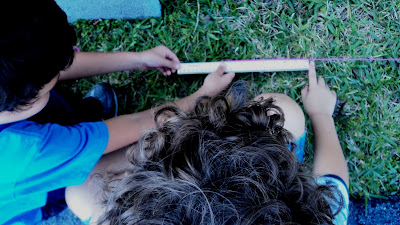The following overview of the Reggio Emilia Approach was taken from a packet of information available at The Hundred Languages of Children traveling exhibit:
Hailed as an exemplary model of early childhood education (Newsweek, 1991), the Reggio Emilia approach to education is committed to the creation of conditions for learning that will enhance and facilitate children's construction of "his or her own powers of thinking through the synthesis of all the expressive, communicative and cognitive languages" (Edwards and Forman, 1993). The Reggio Emilia approach to early childhood education is a city-run and sponsored system designed for all children from birth through six years of age. The Reggio Emilia approach can be viewed as a resource and inspiration to help educators, parents, and children as they work together to further develop their own educational programs. The Reggio Emilia approach is based upon the following principles:
Emergent Curriculum: An emergent curriculum is one that builds upon the interests of children. Topics for study are captured from the talk of children, through community or family events, as well as the known interests of children (puddles, shadow, dinosaurs, etc.). Team planning is an essential component of the emergent curriculum. Teachers work together to formulate hypotheses about the possible directions of a project, the materials needed, and possible parent and/or community support and involvement.
Project Work: Projects, also emergent, are in-depth studies of concepts, ideas, and interests, which arise within the group. Considered as an adventure, projects may last one week or could continue throughout the school year. Throughout a project, teachers help children make decisions about the direction of study, the ways in which the group will research the topic, the representational medium that will demonstrate and showcase the topic and the selection of materials needed to represent the work. Long-term projects or progettazione, enhance lifelong learning.
Representational Development: Consistent with Howard Gardner's notion of schooling for multiple intelligences, the Reggio Emilia approach calls for the integration of the graphic arts as tools for cognitive, linguistic, and social development. Presentation of concepts and hypotheses in multiple forms of representation -- print, art, construction, drama, music, puppetry, and shadow play -- are viewed as essential to children's understanding of experience. Children have 100 languages, multiple symbolic languages.
Collaboration: Collaborative group work, both large and small, is considered valuable and necessary to advance cognitive development. Children are encouraged to dialogue, critique, compare, negotiate, hypothesize, and problem solve through group work. Within the Reggio Emilia approach multiple perspectives promote both a sense of group membership and the uniqueness of self. There high emphasis on the collaboration among home-school-community to support the learning of the child.
Teachers as Researchers: The teacher's role within the Reggio Emilia approach is complex. Working as co-teachers, the role of the teacher is first and foremost to be that of a learner alongside the children. The teacher is a teacher-researcher, a resource and guide as she/he lends expertise to children (Edwards, 1993). Within such a teacher-researcher role, educators carefully listen, observe, and document children's work and the growth of community in their classroom and are to provoke, co-construct, and stimulate thinking, and children's collaboration with peers. Teachers are committed to reflection about their own teaching and learning.
Documentation: Similar to the portfolio approach, documentation of children's work in progress is viewed as an important tool in the learning process for children, teachers, and parents. Pictures of children engaged in experiences, their words as they discuss what they are doing, feeling and thinking, and the children's interpretation of experience through the visual media are displayed as a graphic presentation of the dynamics of learning. Documentation is used as assessment and advocacy.
Environment: Within the Reggio Emilia schools, great attention is given to the look and feel of the classroom. Environment is considered the "third teacher." Teachers carefully organize space for small and large group projects and small intimate spaces for one, two or three children. Documentation of children's work, plants, and collections that children have made from former outings are displayed both at the children's and adult eye level. Common space available to all children in the school includes dramatic play areas and worktables for children from different classrooms to come together.
Features of The Reggio Emilia Approach
Teacher Role:
to co-explore the learning experience with the children
to provoke ideas, problem solving, and conflict
to take ideas from the children and return them for further exploration
to organize the classroom and materials to be aesthetically pleasing
to organize materials to help children make thoughtful decisions about the media
to document children's progress: visual, videotape, tape recording, portfolios
to help children see the connections in learning and experiences
to help children express their knowledge through representational work
to form a "collective" among other teachers and parents
to have a dialogue about the projects with parents and other teachers
to foster the connection between home, school and community
Projects:can emerge from children's ideas and/or interests
can be provoked by teachers
can be introduced by teachers knowing what is of interest to children: shadows, puddles, tall buildings, construction sites, nature, etc.
should be long enough to develop over time, to discuss new ideas, to negotiate over, to induce conflicts, to revisit, to see progress, to see movement of ideas
should be concrete, personal from real experiences, important to children, should be "large" enough for diversity of ideas and rich in interpretive/representational expression
Media:explore first: what is this material, what does it do, before what can I do with the material
should have variation in color, texture, pattern: help children "see" the colors, tones, hues; help children "feel" the texture, the similarities and differences
should be presented in an artistic manner--it too should be aesthetically pleasing to look at--it should invite you to touch, admire, inspire
should be revisited throughout many projects to help children see the possibilities

























